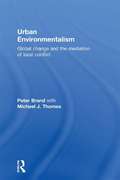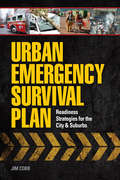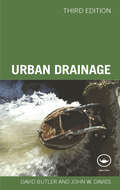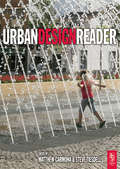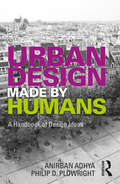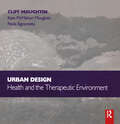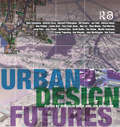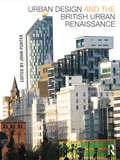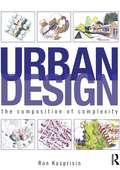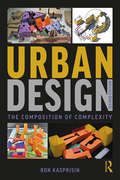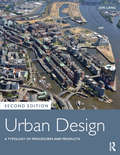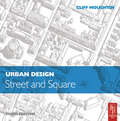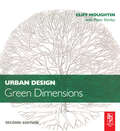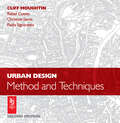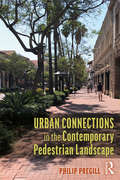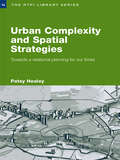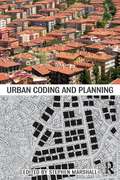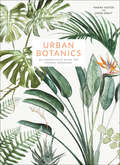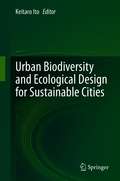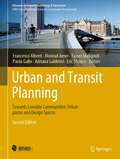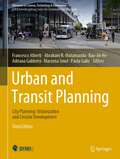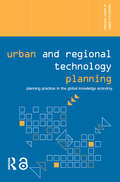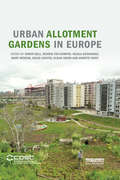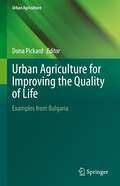- Table View
- List View
Urban Environmentalism: Global Change and the Mediation of Local Conflict
by Michael Thomas Peter BrandA critical examination of urban policies and management practices used to make cities sustainable. With an international perspective, the book describes urban environmental agendas and how they arose in the context of globalization, urban economic restructuring, and the need to make cities competitive. It argues that the environment became an integral part of city development policy, turning attention not only to physical and ecological issues but also to improving the economic performance of cities and the lives of citizens. The authors also go beyond the technical issues to explore the political importance of urban environmentalism, using case studies to illustrate both its international scope and place-specific characteristics which are inexorably influencing city development throughout the world. In connecting the concept to its political effects, the book raises issues such as local democracy, equality and social regulation, all of which are increasingly concerning academics, professionals, environmentalists and city authorities alike.
Urban Emergency Survival Plan: Readiness Strategies for the City and Suburbs
by Jim CobbStay Safe in the City Here's the book that won't advise you to flee the city and set up a homestead to avoid potential disasters. With many other survival-planning resources emphasizing that approach, urban dwellers that plan to stay put in the city, no matter the circumstances, have been overlooked. Not only do 58 percent of Americans live in cities, but certain risks are higher in cities than elsewhere. Urban Emergency Survival Plan delivers a common-sense approach to urban survival planning rather than advocating that city survivalists need to figure out a way to grow an acre of food, raise goats, and build an underground bunker. The clearly outlined approach here will help you to reduce the risks inherent in disasters that occur in well-populated areas. Inside you'll find: Packing lists for get-home bags, everyday carry items for adults and kids and bug-out bags An overview of threats that face an urban area and instructions for planning safe travel during and after disasters, as well as how to plan a temporary escape Instructions for sheltering in place at work Chapters on food storage and water procurement in urban areas with emphasis on limited space and budget A detailed chapter on security options in urban areas A detailed chapter on sanitation, first aid and shelter Ideas for how to respond and cooperate with government disaster plans Photos of important survival gear Discover the skills you'll need to weather any storm, whether you live in an apartment, townhouse, condominium, single-family home or any other urban setting. With planning and practice, you'll gain the confidence to always feel safe in the city.
Urban Drainage, Third Edition
by David Butler John DaviesUrban Drainage has been thoroughly revised and updated to reflect changes in the practice and priorities of urban drainage. New and expanded coverage includes: Sewer flooding The impact of climate change Flooding models The move towards sustainability Providing a descriptive overview of the issues involved as well as the engineering principles and analysis, it draws on real-world examples as well as models to support and demonstrate the key issues facing engineers dealing with drainage issues. It also deals with both the design of new drainage systems and the analysis and upgrading of existing infrastructure. This is a unique and essential textbook for students of water, environmental, and public health engineering as well as a valuable resource for practising engineers.
Urban Design Reader
by Steve Tiesdell Matthew CarmonaEssential reading for students and practitioners of urban design, this collection of essays introduces the 6 dimensions of urban design through a range of the most important classic and contemporary key texts. Urban design as a form of place making has become an increasingly significant area of academic endeavour, of public policy and professional practice. Compiled by the authors of the best selling Public Places Urban Spaces, this indispensable guide includes all the crucial definitions and various understandings of the subject, as well as a practical look at how to implement urban design that readers will need to refer to time and time again. Uniquely, the selections of essays that include the works of Gehl, Jacobs, and Cullen, are presented substantially in their original form, and the truly accessible dip-in-and-out format will enable readers to form a deeper, practical understanding of urban design.
Urban Design Made by Humans: A Handbook of Design Ideas
by Anirban Adhya Philip D. PlowrightThe design of urban environments is complex and involves diverse needs, organisations, professions, authorities, and communities. It requires relationships to be constructed and sustained between infrastructure, resources, and populations across multiple scales. This can be quite daunting. However, at the core of urban design is a simple idea—our urban spaces are designed to allow people and communities to thrive. For that reason, a good starting point for urban designers is to focus on the way people think when engaging our built environment. This thinking is embodied, developed through the interactions between our mind, body, and the environment around us. These embodied concepts are central to how we see the world, how we move and gather, and how we interact with others. They are also the same ideas we use to design our environments and cities. Urban Design Made by Humans is a reference book that presents 56 concepts, notions, ideas, and agreements fundamental to the design and interpretation of our human settlements. The ideas here parallel those found in Making Architecture Through Being Human but extends them into urban environments. Urban Design Made by Humans distinctly highlights priorities in urban design in how we produce meaningful environments catering to wider groups of people. Each idea is isolated for clarity with short and concise definitions, examples, and illustrations. They are organised in five sections of increasing complexity. Taken as a whole, the entries frame the priorities and values of urban design while also being instances of a larger system of human thinking.
Urban Design: Health and the Therapeutic Environment
by Paola Signoretta Kate McMahon Moughtin J.C. Moughtin'Urban Design: Health and the Therapeutic Environment' demonstrates how urban design and planning impact on public health and sustainable development. Moughtin et al. explore the concept of what makes a physically and psychologically ‘healthy’ environment in the context of the paramount need for new homes where living standards are not compromised, in increasingly crowded cities. • Sets out the history and development of the healthy city, from the English spa town to standards of care in Cuba to provide a context for modern urban health development. • Covers a wide range of environmental, ecological, health and epidemiological issues. • Case studies and examples show how health policy and procedure is practically applied to sustainable urban development. 'Urban Design: Health and the Therapeutic Environment' outlines best practice for healthy, sustainable urban design and provides a reference tool for architects, urban designers, landscape architects, health professionals and planners. Emeritus Professor Cliff Moughtin was Professor of Planning in The Queen’s University Belfast and The University of Nottingham. He is author of a number of books including the series of five Urban Design titles for Architectural Press. Kate McMahon Moughtin is a psychotherapist. She is author of Focused Therapy for Organisations and Individuals. She is interested in how literature and environmental infl uences contribute to wellbeing. Paola Signoretta is a human geographer. She is a senior research associate in the Centre for Research in Social Policy, Loughborough University. She is interested in the geographies of health, deprivation and social and financial exclusion.
Urban Design Futures
by Malcolm Moor Jon RowlandThe last decade has seen the rise of urban design which has taken a central position in the new agendas for urban regeneration and renaissance. Urban design has moved from marginality to mainstream. The principles espoused by urban designers over the past thirty years are now accepted as key to a better urban environment and as we move towards greater sustainability, different ideas are emerging that are challenging some of the accepted urban design norms; urban design is at a watershed. Urban Design Futures presents essays from an international cast of authors to review progress and explore emerging ideas: should urban design reflect the future rather than recreate the past? What are the new driving forces that will shape urban living and hence urban design in the future? This book explores new concepts and points the way towards a series of urban design paradigms for the twenty-first century.
Urban Design and the British Urban Renaissance
by John PunterAre Britain’s cities attractive places in which to live, work and play? Asking that question, this is a critical review of how the design dimension of the Urban Renaissance strategy was developed and applied, based on expert academic assessments of progress in Britain’s thirteen largest cities. The case studies are preceded by a dissection of New Labour’s renaissance agenda, and concluded by a synthesis of achievements and failings. Exploring the implications of this strategy for the future of urban planning and design, this is a must-read for students, practitioners of these subjects and for all those who wish to improve the quality of the British urban environment.
Urban Design: The Composition of Complexity
by Ron KasprisinFor planning to be successful, design must mean more than simply blindly following the dictates of legislation and regulation – yet losing sight of the importance of the design process is all too often exactly what has happened. Ron Kasprisin has written a book for students of planning and urban design that reconnects the process of designing with outcomes on the ground, and puts thinking about design back at the heart of what planners do. The book identifies the elements and principles of composition and explores compositional order and structure as they relate to the meaning and functionality of cities. It discusses new directions and methods, outlines the importance of both buildings and the open spaces between them. Mixing accessible theory, practical examples and carefully designed exercises in composition from simple to complex settings, Urban Design is an essential textbook for classrooms and design studios across the full spectrum of planning and urban studies fields. Not only filled with illustrations and graphics of excellent projects, it gives students tools to enable them to sketch, draw, design and above all, to think.
Urban Design: The Composition of Complexity
by Ron KasprisinUrban design is a process of establishing a structural order within human settlements; responding to dynamic emergent meanings and functions in a constant state of flux. The planning/design process is complex due to the myriad of on-going (urban) organizational and structural relationships and contexts. This book reconnects the process with outcomes on the ground, and puts thinking about design back at the heart of what planners do. Mixing accessible theory, practical examples, and carefully designed exercises in composition from simple to complex settings, Urban Design is an essential textbook for classrooms and design studios across the full spectrum of planning and urban studies fields. Filled with color illustrations and graphics of excellent projects, it gives students tools to enable them to sketch, draw, design, and above all, to think. This new edition remains focused on instructing the student, professional and layperson in the elements and principles of design composition so that they can diverge from conventional and packaged solutions in pursuit of a meaningful and creative urbanism. This edition builds upon established design principles and encourages the student in creative ways to depart from them as appropriate in dealing with the complexity of culture, space and time dynamics of cities. The book identifies the elements and principles of compositions and explores compositional order and structure as they relate to the meaning and functionality of cities. It discusses new directions and methods, and outlines the importance of both buildings and the open spaces between them.
Urban Design: A Typology of Procedures and Products
by Jon LangUrban Design: A Typology of Procedures and Products, 2nd Edition provides a comprehensive and accessible introduction to urban design, defining the field and addressing the controversies and goals of urban design. Including over 50 updated international case studies, this new edition presents a three-dimensional model with which to categorize the processes and products involved: product type, paradigm type, and procedural type. The case studies not only illuminate the typology but provide information that designers can use as precedents in their own work. Uniquely, these case study projects are framed by the design paradigm employed, categorized by procedural type instead of instrumental or land use function. The categories used here are Total Urban Design, All-of-a-piece Urban Design, Plug-in Urban Design, and Piece-by-piece Urban Design. Written for both professionals and those encountering urban design in their day-to-day life, Urban Design is an essential introduction to the field and practice, considering the future direction of the field and what can be learned from the past.
Urban Design: A Typology of Procedures and Products
by Jon LangUrban Design: A Typology of Procedures and Products, 2nd Edition provides a comprehensive and accessible introduction to urban design, defining the field and addressing the controversies and goals of urban design. Including over 50 updated international case studies, this new edition presents a three-dimensional model with which to categorize the processes and products involved: product type, paradigm type, and procedural type. The case studies not only illuminate the typology but provide information that designers can use as precedents in their own work. Uniquely, these case study projects are framed by the design paradigm employed, categorized by procedural type instead of instrumental or land use function. The categories used here are Total Urban Design, All-of-a-piece Urban Design, Plug-in Urban Design, and Piece-by-piece Urban Design.Written for both professionals and those encountering urban design in their day-to-day life, Urban Design is an essential introduction to the field and practice, considering the future direction of the field and what can be learned from the past.
Urban Design: Street And Square (Urban Design Ser.)
by Cliff MoughtinThis book, part of a series of four, offers a detailed analysis of urban design, covering the streets, squares and buildings that make up the public face of towns and cities. It outlines the theory of the principal features of urban design from which method is developed and provides a better understanding of the main elements of urban design. This includes the arrangement, design and details of the streets and squares, and the roles they play in city planning.This third edition includes chapters on "Sustainable Urban Design" and "Visual Analysis", introducing the latest theories and influences in the field and bringing greater practical significance to the book. Cliff Moughtin explores the street and square in terms of function, structure and symbolism and examines fine examples in their historical context. These are set against the background of the laws of urban design composition, culled from Renaissance and modern writers.
Urban Design: Green Dimensions (Urban Design)
by Peter Shirley Cliff MoughtinIn Green Dimensions, Cliff Moughtin relates sustainable development and green design to the realm of urban design and development. Examining regional and local frameworks for design and planning, this book shows how sustainable urban design can be implemented on every scale.Working from a strong theoretical base, the author uses case studies and discusses policy developments, in order to challenge the conventional wisdom onsustainable design. The book provides a rounded discussion of the application and suitability of current practice, and predicts future design needs.Updating the reader on topics such as energy efficiency, sustainable city forms and the culture of new urbanism, this completely revised and restructured second edition also includes brand new chapters on the Urban Park and Bio-diversity.
Urban Design: Method And Techniques
by Paola Signoretta Rafael Cuesta Christine Sarris J.C MoughtinThis book deals with a wide range of techniques used in the urban design process. It then goes on to relate these techniques to a unique, comprehensive account of method. A method of urban design is developed which has sustainability and environmental protection at the centre of its philosophy. Previously, literature regarding the urban design method has been almost totally neglected; this book introduces the topic to the reader. This revised Second Edition encompasses the latest techniques including the development of geographic information systems and financial techniques which help evaluate projects.A number of techniques are illustrated by example or case study. Where techniques are discussed they are located within the structure of the design process. The book develops a logical framework for a process, which includes problem definition, survey, analysis, concept generation, evaluation and implementation. It is this framework which leads toward the development of an urban design method. This book is a practical guide for students or professionals in the early part of their careers. It is organized so that each chapter provides guidance which readers would have otherwise had to discover for themselves, often with some difficulty.
Urban Connections in the Contemporary Pedestrian Landscape
by Philip PregillUrban Connections in the Contemporary Pedestrian Landscape explores the significant physical and cultural changes in our urban areas following the implementation of design strategies and increased pedestrian activity. Beginning with a history of the urban grid, the book then discusses experiential factors of pedestrianized urban landscapes in three scales, arterials, collectors and locals, with an emphasis on inductive and deductive design alternatives. It closely examines elements derived from current urban pedestrian experiences including form, scale, surfaces and identity and provides alternative design solutions for the future. Uniquely focusing on a hierarchical discussion of the quality of contemporary landscape design applications within the urban grid, and with illustrated examples throughout the text, this will be useful recommended reading for academics, researchers and postgraduate students on urban landscape and design courses.
Urban Complexity and Spatial Strategies: Towards a Relational Planning for Our Times (RTPI Library #14)
by Patsy HealeyUrban Complexity and Spatial Strategies develops important new relational and institutionalist approaches to policy analysis and planning, of relevance to all those with an interest in cities and urban areas. Well-illustrated chapters weave together conceptual development, experience and implications for future practice and address the challenge of urban and metropolitan planning and development. Useful for students, social scientists and policy makers, Urban Complexity and Spatial Strategies offers concepts and detailed cases of interest to those involved in policy development and management, as well as providing a foundation of ideas and experiences, an account of the place-focused practices of governance and an approach to the analysis of governance dynamics. For those in the planning field itself, this book re-interprets the role of planning frameworks in linking spatial patterns to social dynamics with twenty-first century relevance.
Urban Coding and Planning: Urban Coding And Planning (Planning, History and Environment Series)
by Stephen MarshallUrban codes have a profound influence on urban form, affecting the design and placement of buildings, streets and public spaces. Historically, their use has helped create some of our best-loved urban environments, while recent advances in coding have been a growing focus of attention, particularly in Britain and North America. However, the full potential for the role of codes has yet to be realized. In Urban Coding and Planning, Stephen Marshall and his contributors investigate the nature and scope of coding; its purposes; the kinds of environments it creates; and, perhaps most importantly, its relationship to urban planning. By bringing together historical and ongoing traditions of coding from around the world – with chapters describing examples from the United Kingdom, France, India, China, Japan, Australia, South Africa, the United States and Latin America – this book provides lessons for today’s theory and practice of place-making.
Urban Botanics: An Indoor Plant Guide for Modern Gardeners
by Maaike Koster Emma SibleyHave trouble keeping house plants alive? Struggling to find your green fingers? Fear not! You can still have a beautiful plant-filled home with this stunning guide to indoor plants. Whether you are looking to cultivate an entire indoor garden, or simply wish to know more about your single cactus, you can be sure to find the right information for you amongst the seventy-five plants in this stylish guide. And the best bit? All the plants are easy to maintain so even the most timid of gardeners can enjoy turning their hand to this green-fingered pastime. Learn how to care for succulents, cacti, flowering and foliage plants even with a full-time job, with this unique gardening guide that is made to fit alongside our modern-day schedules. With endless inspiration to brighten up your home,desk or office, this beautiful book of plants from across the world is a must for lovers of art and design, as well as plants.
Urban Biodiversity and Ecological Design for Sustainable Cities
by Keitaro ItoThis book highlights various designs for urban green spaces and their functions. It provides an interesting meeting point between Asian, European and North America specialists (researchers, planners, landscape architects) studying urban biodiversity; urban biodiversity and green space; relations between people and biodiversity. The most important feature of this book is the unique point of view from each contributor towards “the relationship between nature and people in urban areas”, in the context of the ecosystem and biodiversity in urban areas and how to manage them. All chapters explore and consider the relationship between humans and nature in cities, a subject which is taking on increasing importance as new cities are conceptualized and planned. These discussion and examples would be useful for urban ecology researchers, biologists, city planners, government staff working in city planning, architects, landscape architects, and university instructors. This book can also be used as a textbook for undergraduate and postgraduate city planning, architecture or landscape architecture courses.
Urban and Transit Planning: Towards Liveable Communities: Urban places and Design Spaces (Advances in Science, Technology & Innovation)
by Francesco Alberti Mourad Amer Yasser Mahgoub Paola Gallo Adriana Galderisi Eric StraussThis book incorporates a wealth of research focused on the more and more urgent challenges that urban planning and architectural design all over the world must cope with: from climate change to environmental decay, from an increasing urban population to an increasing poverty. In detail, this book aims at providing innovative approaches, tool and case study examples that, in line with the agenda of 2030, may better drive human settlements toward a sustainable, inclusive and resilient development. To this aim, the book includes heterogeneous regional perspectives and different methodologies and suggests development models capable of limiting further urban growth and re-shaping existing cities to improve both environmental quality and the overall quality of life of people, also taking account the more and more close relationships among urban planning and technological innovation.
Urban and Transit Planning: City Planning: Urbanization and Circular Development (Advances in Science, Technology & Innovation)
by Francesco Alberti Abraham R. Matamanda Bao-Jie He Adriana Galderisi Marzena Smol Paola GalloThis book represents a compilation of research in sustainable architecture and planning. Its main focus is offering strategies and solutions that help reducing of the negative impacts of buildings on the environment and emphasizing the suitable management of available resources. By tackling the topic of sustainability from a historical perspective and also as a vision for the future, the book in hands provides new horizons for engineers, urban planners and environmentalists interested in the optimization of resources, space development, and the ecosystem as a whole to address the complex unresolved problems our cities are facing. This book is a culmination of selected research papers from IEREK’s sixth edition of the International Conference on Urban Planning & Architectural Design for Sustainable Development (UPADSD) held online in collaboration with the University of Florence, Italy (2021) and the first edition of the International Conference on Circular Economy for Sustainable Development (CESD) held online in collaboration with the University of Salento, Lecce, Italy (2021).
Urban and Regional Technology Planning: Planning Practice in the Global Knowledge Economy (Networked Cities Series)
by Kenneth E. Corey Mark WilsonPart of the popular Networked Cities series, Urban and Regional Technology Planning focuses on the practice of relational planning and the stimulation of local city-regional scale development planning in the context of the global knowledge economy and network society. Designed to offer scholars, practitioners, and decision makers studies on the ways of cities, technologies, and multiple forms of urban movement intersect and create the contemporary urban environment, Kenneth Corey and Mark Wilson explore the dynamics of technology-induced change that is taking place within the context of the global knowledge economy and network society. Examining first the knowledge economy itself, Wilson and Corey go on to discuss its implications before proposing ways to strategize for future intelligent development, with particular emphasis on the ALERT model for regional and local planning. An important read for those practicing or studying planning in this network society.
Urban Allotment Gardens in Europe
by Mary Benson Simon Bell Susan Noori Runrid Fox-Kämper Nazila Keshavarz Silvio Caputo Annette VoigtAlthough urban allotment gardening dates back to the nineteenth century, it has recently undergone a renaissance of interest and popularity. This is the result of greater concern over urban greenspace, food security and quality of life. This book presents a comprehensive, research-based overview of the various features, benefits and values associated with urban allotment gardening in Europe. The book is based on a European COST Action project, which brings together researchers and practitioners from all over Europe for the first detailed exploration of the subject on a continent-wide scale. It assesses the policy, planning and design aspects, as well as the social and ecological benefits of urban allotment gardening. Through an examination of the wide range of different traditions and practices across Europe, it brings together the most recent research to discuss the latest evolutions of urban allotment gardening and to help raise awareness and fill knowledge gaps. The book provides a multidisciplinary perspective, including insights from horticulture and soil science, ecology, sociology, urban geography, landscape, planning and design. The themes are underpinned by case studies from a number of European countries which supply a wide range of examples to illustrate different key issues.
Urban Agriculture for Improving the Quality of Life: Examples from Bulgaria (Urban Agriculture)
by Dona PickardThis book presents the findings of a multidisciplinary study on the effects of urban agriculture (UA) on the social, economic and environmental aspects of the quality of life in Sofia - the capital of Bulgaria. The analyses are based on a sociological survey representative of 3 districts of Sofia (among 750 people), in-depth interviews, focus groups, expert statements, ecological monitoring of UA sites, and spatial mapping of natural resources for UA. It also focuses on UA effects on the social well-being of citizens and communities, the correlation between social capital and UA attitudes, the challenges for UA to integrate disadvantaged social groups, the factors for success of small UA businesses, as well as the role of policy and civil society in developing UA. This work is also important for the analysis of the underlying links between all aspects of urban agriculture, many of which are valid beyond the local socio-economic context and environmental specifics of the city of Sofia.
